Units of Measurement, Technical Tables, and Symbols
Data presented in this chapter have been drawn from the U.S. Standard Atmosphere, 1976, the Metric Design Guide, the Air Force Recovery Systems Design Guide (Reference 2.1), Navy manuals, and other sources as referenced in section 3.5.
The symbols and abbreviations used in parachute recovery system design and analysis contained in section 3.4 agree with those listed in Navy manuals and the Air Force Recovery Systems Design Guide.
UNITS OF MEASUREMENT
Basic Units
| Metric | English | |||
|---|---|---|---|---|
| Quantity | Symbol | Name | Symbol | Name |
| Length | m | meter | ft | foot |
| Mass | kg | kilogram | lb | pound |
| Time | s | second | s | second |
| Temperature | K | Kelvin | R | Rankine |
| Electric Current | A | ampere | A | ampere |
Derived Units
| Quantity | Symbol | Name | Dimension |
|---|---|---|---|
| Force | N | newton | kg.m/s2 |
| Pressure | Pa | pascal | N/m2 |
| Work, energy | J | joule | N.m |
| Rate of energy | W | watt | J/s |
The metric units of measurement defined in sections 3.1.1 and 3.1.2 are used by physicists, but seldom by engineers who work with English units of measurement.
Engineering Units of Measurement
Length
One statute mile (mi) = 1760 yards (yd) = 5280 feet (ft)
One foot = 12 inches (in.)
One kilometer (km) = 1000 meters (m)
One meter = 100 centimeters (cm)
One centimeter = 10 millimeters (mm)
One millimeter = 10,000 microns
One meter = 103 millimeters = 107 microns = 1010 angstroms
Area
One square mile (mi2) = 640 acres = 3,097,600 square yards (yd2)
One square yard = 9 square feet (ft2)
One square foot = 144 square inches (in2)
One square kilometer (km2) = 1,000,000 square meters (m2)
One square meter = 10,000 square centimeters (cm2)
One square centimeter = 100 square millimeters (mm2)
Volume
One cubic yard (yd3) = 27 cubic feet (ft3)
One cubic foot = 7.48 gallons (gal) = 1728 cubic inches (in3)
One cubic meter (m3) = 1000 liters (L)
One liter = 1000 cubic centimeters (cm3) = 1000 milliliters
One cubic centimeter = 1000 cubic millimeters (mm3)
Weight
One English ton = 2000 pounds (lb)
One pound = 16 ounces (oz)
One ounce = 437.5 grains (gr)
One metric ton = 1000 kilograms (kg)
One kilogram = 1000 grams (g)
Force
One pound force = 4.44822 newtons (N)
One kilogram force = 9.80665 newtons
Pressure
One pound per square inch (psi) = 144 pounds per square foot (lb/ft2)
One atmosphere (atm) = 14.696 psi = 29.921 inches of mercury (in. Hg)
One kilogram per square centimeter (kg/cm2) = one technical atmosphere
One pascal (Pa) = one newton per square meter (N/m2)
Torr, millibar, and psi are used to define atmospheric pressure. See tables in section 3.2 for conversion between units.
Power
One horsepower (HP) = 0.74S7 kilowatt (kW) = 550 foot-pounds per second (ft-Ibis)
One metric horsepower = 75 kg-m/s = 0.9863 English horsepower
Specific Weight
One pound per cubic inch (lb/in3) = 1728 pounds per cubic foot (lb/ft3)
One gram per cubic centimeter (g/cm3) = one kilogram per liter (kg/L) = one metric ton per cubic meter (ton/m3)
Density,Y, is expressed in lb/ft3
Specific weight, w, is expressed in g/cm3
Mass density, ρ, is expressed in slug/ft3 or kgs2/m4
Temperature
Absolute zero = zero degrees Kelvin (°K) = -273.16 degrees Celsius (°C); or -459.67 degrees
Fahrenheit (°F) = zero degrees Rankine (°R)
Velocity
One knot = 1 nautical mile (nmi) per hour = 1852 meters per hour (m/h)
One mile per hour (mph) = 1.4667 feet per second (ft/s)
One kilometer per hour (km/h) = 0.27778 meter per second (m/s)
Acceleration
Acceleration is measured as velocity change per second (ft/s2)
Acceleration of gravity, g, (ft/s2, m/s2) is the acceleration of any free-falling body toward the center of the Earth (see section 4.1.5).
CONVERSION TABLES
Conversion Table 3.1 is based on tables used in the aerospace industry and has been updated with information contained in References 3.1 to 3.4. Table 3.2 provides a convenient method to convert temperature data from Fahrenheit to Celsius, or vice versa.
TECHNICAL TABLES
Earth's Atmosphere
The Earth is surrounded by a blanket of gas pressing statically against its surface and making up its atmosphere. Atmospheric pressure, density, temperature, and the speed of sound vary with altitude.
Table 3.3 lists, versus altitude, the static pressure, p, in lb/ft2; the mass density, ρ, in slugs/ft3; the temperature, T, in °F; and the speed of sound, Cs, in ft/s. These data are taken from the U.S. Standard Atmosphere, 1976 (Reference 3.4). The altitude scale is represented by a vertical on the Earth's surface extending through the center of the Earth. The data in Tuble 3.3 are averages, varying with seasonal weather changes and the fact that the Earth is not a perfect sphere. The U.S. Standard Atmosphere, 1976, which contains a detailed discussion of these variations, includes data for higher altitudes.
Pressure and mass density decrease gradually with altitude. At an altitude of approximately 275,000 feet, continuum flow gradually changes to molecular flow, and, subsequently, to atomic flow. Sustained flight of aircraft with air-breathing engines ceases to be practical at altitudes approaching 100,000 feet because of the low density of the atmosphere.
The temperature gradually decreases with altitude to 37,000 feet, remains constant to 65,000 feet, and then increases again. A second temperature reversal occurs at approximately 160,000 feet (Reference 3.4). Figure 3·1 shows the altitude dependency of temperature and speed of sound. The close relationship between temperature and speed of sound is discussed in Chapter 4.
The value 1 permits the determination of rate of descent at any altitude. For example, a parachute with a sea-level rate of descent, Veo, of 20 ft/s has a rate of descent, Ve, at 40,000 feet of 20 x 1/ = 20 x 2.0118 = 40.24 ft/s.
Dynamic Pressure
Chapter 4 contains an explanation of the importance of dynamic pressure, q, in all aerodynamic calculations. Figure 3.2 gives dynamic pressure in Ib/ft2 in relation to altitude, Mach number, and true airspeed. These graphic values should be used only for preliminary calculations. Final dynamic pressure values should be calculated using the method shown in Chapter 4.
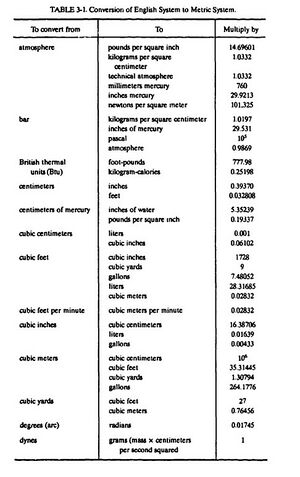
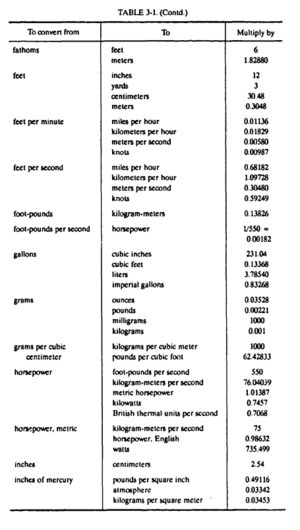
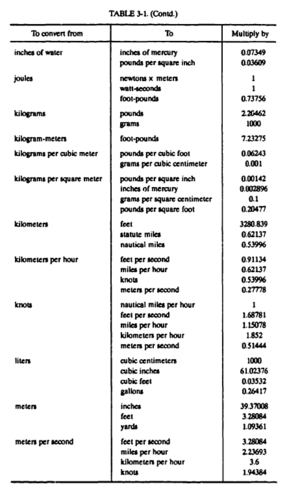
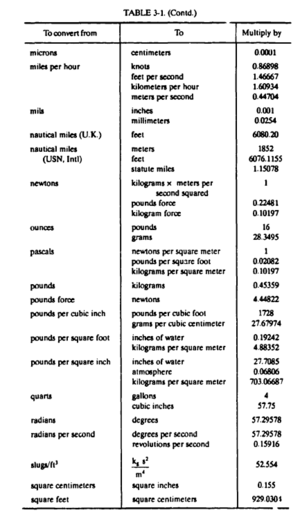

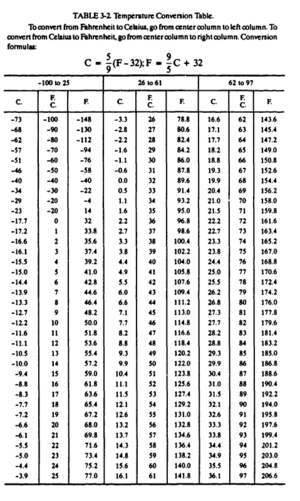
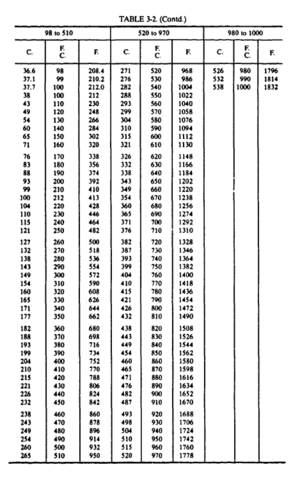

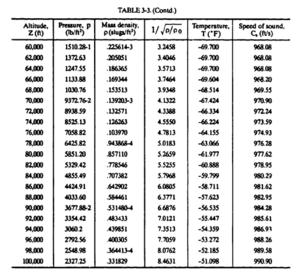
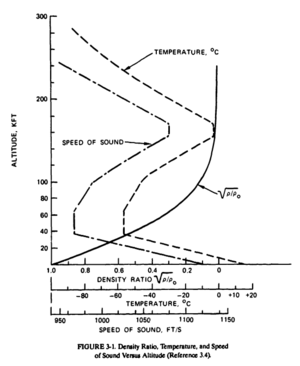
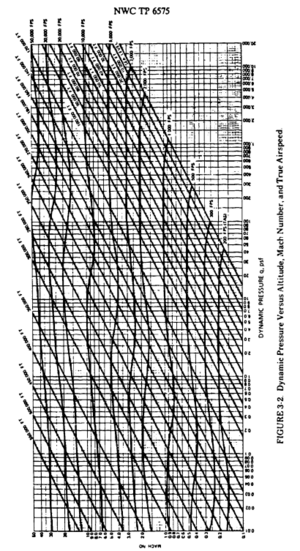
LIST OF SYMBOLS
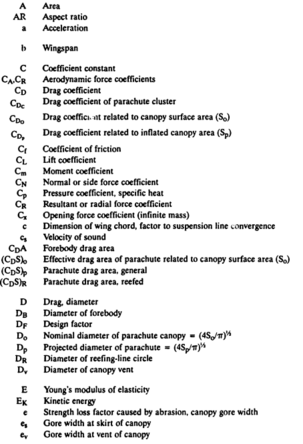
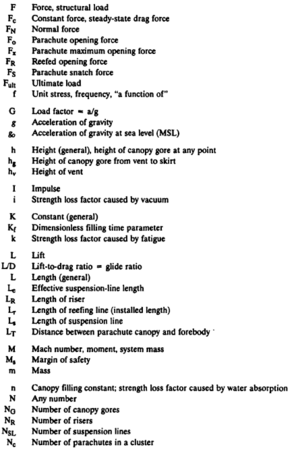
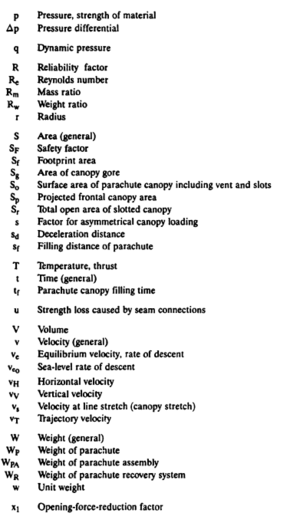
Greek and Mathematical Symbols
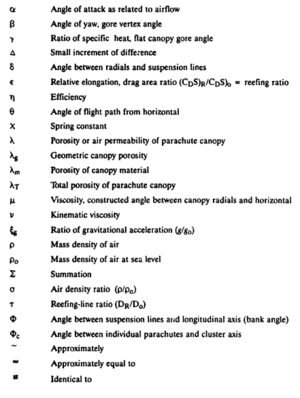
REFERENCE MATERIAL
3.1 The International System of Units (SI), National Bureau of Standards Special Publication 330, issued December 1981, Superintendent of Documents, Government Printing Office, Washington D.C. 20404.
3.2 Metric Practice Guide, March 1970, ASTM Designation E-380-70, American Society for Testing and Materials, 1916 Race St., Philadelphia, Pa. 19103.
3.3 Lionel S. Marks, Mechanical Engineers Handbook, McGraw Hill Book Co.
3.4 U.S. Standard Atmosphere, 1976, published by National Oceanic and Atmospheric Administration, NASA, U.S. Air Force. Superintendent of Documents Stock No. 003-017-00323-0, Government Printing Office, Washington, D.C. 20402.
